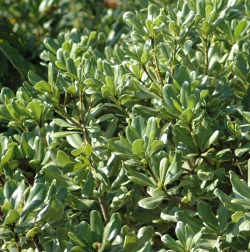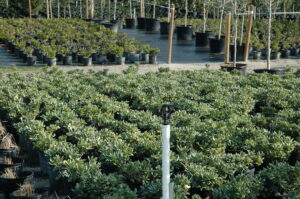S & J Nursery’s Variegated Pittosporum
/ Variegated Mock Orange
( Pittosporum Tobira ‘variegata’)
– This Japanese native plant is not just popular for the landscape but has been a long used interior cut foliage plant.
Variegated Pittosporum / Mock Orange Preferred Exposure:
– Variegated Pittosporum plants will prefer full sun to partial shade locations in the North Florida | St. Augustine | Jacksonville area landscape.
Variegated Pittosporum Foliage:
– Glossy variegated green and white foliage of the Variegated Pittosporum
has a full lush growth habit .
Variegated Pittosporum Soil Preference / Salt tolerance:
– Pittosporums are widely tolerant of many soil conditions but are said to prefer the slightly acid conditions common in the North Florida landscape. Provide well draining soils and don’t plant Pittosporum Tobira in wet soils, as root rot can become a problem.
– Pittosporum Tobira has a high salt tolerance and is an excellent landscape shrub or small ornamental tree choice for coastal properties and can be planted right along the ocean side.
Variegated Pittosporum Size Variance:
– Variegated Pittosporum can reach sizes of 8-12+ feet High | 12+ feet Wide but is often maintained as low as 3ft with just semi annual pruning as these plants respond well to heavy prunings.
Variegated Pittosporum / Mock Orange Growth Habit:
– Variegated Pittosporum has a rounded growth habit and needs little or no pruning to keep its shape.
Variegated Pittosporum Growth Rate:
– Pittosporum Tobira has a fast growth rate especially in its younger years in the landscape. If using this plant as a shrub for foundation plantings or hedges remember to prune them back 4-6 inches beneath where you would like to see their growth be to avoid having to trim again soon, this will allow
the plant a little room to grow as it will immediately after pruning and fertilizing put out a new flush of growth 4-6 inches wide and high, filling in multiple branches at each pruning point.
Variegated Pittosporum Bloom:
-This plant was often referred to as Mock Orange, the thick, waxy clusters of white blooms in spring are extremely fragrant and strongly resemble the fragrance of an orange blossom. The flowers last only a month or so a
Variegated Pittosporum / Mock Orange Water Requirements:
– Green Pittosporum is extremely drought tolerant once established into the
landscape and requires very little attention to daily watering except when first being planted from the nursery containers into the landscape, especially during North Florida | Jacksonville | St. Augustine area’s hot summer months.
Butterfly or Bird Attracting:
– Variegated Pittosporum is not touted to be a wildlife attractor for the
landscape.
Best Uses For Variegated Pittosporum / Mock Orange :
– Variegated Pittosporum can be used as a hedge screen for privacy or to block unsightly views, mass landscape plantings, foundations of home or commercial buildings, low maintenance small scale ornamental accent or tree, Pittosporum Tobira will even make a good container plant
– Few pest or disease problems in the North Florida | Jacksonville | St. Augustine area landscapes when planted into well draining soils.
Care of S & J Nursery’s North Florida | Jacksonville | St. Augustine
Shrubs:
– Shrubs can be planted in the North Florida | Jacksonville | St.Augustine area at any time during the year. In normal and well draining soils dig the hole as deep as the root ball and two to three times as wide. Plant the top of the root ball level or slightly higher than the surrounding soils. When
planting in poorly drained soils make sure to plant your shrubs a minimum of 3 inches ABOVE the surrounding soil level.
– Water every day during the establishment period. For most 3 gallon size shrubs in the North Florida landscape in average soil, that is neither heavy clay that holds water or really sandy that will take 2-3 weeks of daily watering to ensure that your newly planted shrub will begin to put out new roots and grow into its new home happily. After the first few weeks begin tapering back your watering to every other day then every third day and so on until your newly planted items are flourishing without your assistance.
– If planting larger shrubs you may need to extend the initial care a bit longer to protect your investment and get your shrubs off to the best start possible.
– IMPORTANT: If planting shrubs in heavy clay soils that hold allot of water after a rain or irrigating, remember to check the soil for moisture by sticking your fingers into the soil near the root
ball of the newly planted shrub down to 2-3 inches. If it remains wet from the previous watering wait for the top 2-3 inches to dry out before watering again.
– IMPORTANT: When planting shrubs into poor sandy soils be sure to amend the planting hole by mixing compost or cow manure etc. with the native soil that will go back in the hole around the new plants root ball when installing your shrub material, this will not only give your new shrubs good soil to grow its new roots into but help it hold water.
– When planting shrubs from containers be sure to loosen the roots as much as possible pulling loose roots away from the root ball before installing your new plants, if the roots are to tight to easily loosen with your hands use a knife to cut a few slits into the root ball being careful to go all the way from the top to the bottom and making the cut at least an inch deep. This will ensure that your plant will immediately begin to form new roots into its new surrounding soil.
– Mulch newly planted shrubs whenever possible.
– Fertilize each spring with a mixture of milorganite and a slow release poly coated plant food such as Osmocote or Stay Green general purpose plant food, sprinkling the fertilizer around the mulch circle underneath the foliage of the tree.
– Prune as needed to shape each spring and or summer.

